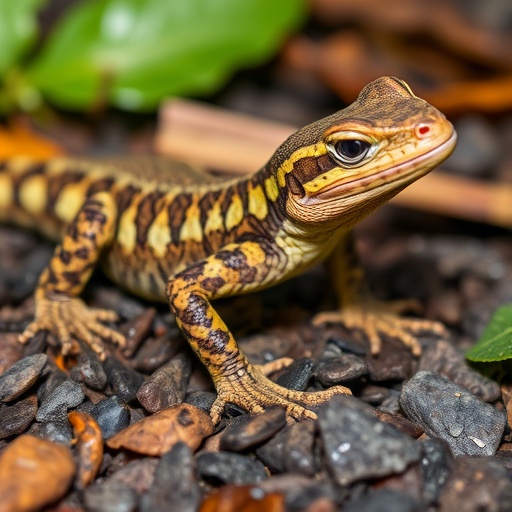In the bustling urban landscape of New Orleans, a surprising discovery has emerged from the field of environmental toxicology and evolutionary biology that challenges long-held assumptions about mammalian and vertebrate susceptibility to heavy metal poisoning. Recent research conducted by a team at Tulane University has unveiled that the brown anole lizards (Anolis sagrei), an invasive reptilian species long established in the city, harbor blood-lead concentrations that eclipse all previously documented levels observed in vertebrates. Intriguingly, despite harboring lead burdens deemed lethal to most animal taxa, these lizards not only survive but thrive, revealing remarkable physiological and genetic adaptations to a heavily contaminated environment.
This groundbreaking study, published in the latest issue of Environmental Research, meticulously quantifies the blood-lead content in these small reptiles and contrasts the findings with established toxicity thresholds across fish, amphibians, birds, mammals, and other reptiles. The research team, led by assistant professor Alex Gunderson alongside PhD candidate Annelise Blanchette, utilized a multifaceted experimental design incorporating in vivo performance assessments and transcriptomic analyses to explore both phenotypic resilience and underlying molecular mechanisms that confer lead tolerance.
Lead is a pervasive and persistent environmental toxin with notorious neurotoxic effects, particularly associated with urban contamination resultant from legacy industrial pollution, leaded gasoline residues, lead-based paints, and deteriorating infrastructure. The presence of such toxicants in urban fauna is often correlated with significant physiological impairments and population declines. However, the brown anole lizards of New Orleans defy this paradigm. Blood-lead levels measured in these reptiles set unprecedented records, with concentrations roughly tenfold greater than previously recorded chronic exposure levels in similar taxa, yet these individuals maintain full locomotor function, cognitive capacity, and metabolic efficiency—a true anomaly in vertebrate ecotoxicology.
Detailed behavioral assays examined critical performance indicators known to be vulnerable to heavy metal toxicity, including sprint speed, endurance under exertion, and balance. Remarkably, the brown anoles displayed no decrements in these functions relative to low-exposure conspecifics. This suggests robust physiological processes at play that mitigate or neutralize lead’s deleterious effects at cellular and systemic levels. The sublethal tolerance thresholds identified challenge existing toxicological models and call for a reevaluation of vertebrate lead toxicity benchmarks.
At the molecular level, transcriptome sequencing of brain and liver tissues revealed only subtle perturbations in gene expression profiles, with a small subset of genes related to metal ion transport, homeostasis, and oxidative stress response showing differential regulation. The preservation of neuronal and hepatic function despite such toxic loads implies sophisticated mechanisms of detoxification, metal sequestration, or cellular repair that operate effectively in these lizards. Further elucidation of these pathways could illuminate evolutionary adaptations underpinning urban survival and provide novel insights into mitigating heavy metal poisoning in other species.
The ecological implications are equally compelling. Brown anoles, originally native to the Caribbean, have been established in New Orleans for decades but have gained dominance over the native green anole species in recent years. Their success in contaminated urban environments may partly be attributed to this exceptional lead tolerance, allowing them to exploit niches where competitors are hampered by pollutant burdens. This paradigm of urban ecological adaptation invites a deeper understanding of invasive species dynamics and the evolutionary pressures posed by anthropogenic contaminants.
From an evolutionary biology perspective, this case study underscores the complex interplay between environmental stressors and genomic plasticity. The observation that brown anoles endure lead concentrations previously considered insurmountable suggests rapid, perhaps recent, evolutionary shifts or preexisting genotypic variability that confers resilience. Studying these adaptations offers a unique window into vertebrate evolutionary responses to accelerated urbanization and pollution gradients.
Beyond its biological significance, this research holds translational potential. Understanding how certain vertebrates circumvent lead toxicity at genetic, biochemical, and physiological levels can inspire innovative approaches to human and wildlife health. The identification of protective molecular mechanisms may inform therapeutic strategies for lead poisoning, a still prevalent public health issue, especially in environmentally marginalized communities.
It is critical to emphasize that this study does not imply humans or other vertebrates can naturally acquire similar levels of tolerance. Instead, it highlights the urgent need to remediate environmental lead contamination due to its well-documented adverse effects on human health, particularly on developing children and vulnerable populations. The persistence of lead in urban sediment and biota after decades of regulatory action exemplifies the challenges faced in mitigating legacy pollution.
This study also prompts a reevaluation of environmental risk assessments that underpin regulatory standards and wildlife conservation guidelines. If certain vertebrates demonstrate previously unrecognized tolerance thresholds, environmental policies may require refinement to better reflect species-specific vulnerabilities and resilience.
In conclusion, Tulane University’s research unveils a novel biological phenomenon with profound implications for ecology, toxicology, evolutionary biology, and public health. The brown anole’s extraordinary lead tolerance redefines toxicity paradigms and opens exciting avenues for future investigations into urban adaptation, evolutionary mechanisms in contaminated habitats, and biomimetic applications for mitigating heavy metal exposure.
Subject of Research: Animals
Article Title: Unprecedented lead tolerance in an urban lizard
Web References: https://www.sciencedirect.com/science/article/pii/S0013935125017839?utm_campaign=STMJ_220042_AUTH_SERV_PA&utm_medium=email&utm_acid=140441009&SIS_ID=&dgcid=STMJ_220042_AUTH_SERV_PA&CMX_ID=&utm_in=DM588831&utm_source=AC_
Keywords: Environmental sciences, Applied ecology, Ecosystems, Chemical decomposition, Environmental toxicology, Environmental management, Natural resources management, Ecological risks, Ecological degradation, Conservation ecology, Animal physiology, Evolution, Evolutionary developmental biology, Evolutionary ecology, Evolutionary genetics




